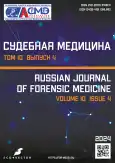Преднамеренное самоповреждение среди пациентов больницы третичного звена в сельской местности Южной Индии: исследование социально-демографического профиля, методов и сопутствующих факторов
- Авторы: Hosahally J.S.1, Raj N.B.1, Geetha K.B.1
-
Учреждения:
- Dr Chandramma Dayananda Sagar Institute of Medical Education and Research Dayananda Sagar University
- Выпуск: Том 10, № 4 (2024)
- Страницы: 517-528
- Раздел: Оригинальные исследования
- URL: https://journal-vniispk.ru/2411-8729/article/view/288321
- DOI: https://doi.org/10.17816/fm16185
- ID: 288321
Цитировать
Аннотация
Обоснование. Преднамеренное самоповреждение — аутоагрессивное поведение с наличием или отсутствием суицидальных намерений, не приводящее к летальному исходу. Этот термин охватывает широкий спектр поведения, но обычно характеризуется как преднамеренное добровольное причинение вреда самому себе и включает такие действия, как повешение, отравление и порезы, с наличием или отсутствием суицидальных намерений.
Цель исследования ― выявить различные методы, используемые для преднамеренного самоповреждения, а также изучить их связь с полом и возрастом.
Материалы и методы. Это проспективное одномоментное исследование, в котором проанализированы все случаи преднамеренного самоповреждения, зафиксированные в Dr. Chandramma Dayananda Sagar Institute of Medical Education and Research с октября 2022 г. по февраль 2024 г.
Результаты. В исследовании рассматривали 98 случаев, отвечающих критериям включения. Гендерное распределение среди участников исследования отражает преобладание женщин: 63,27 против 36,73%. В 88,78% случаев использовали ненасильственные методы самоповреждения. Самым распространённым насильственным методом была попытка повешения, а ненасильственным — употребление пестицидов, что составило 63,64 и 63,21% соответственно. Частота случаев передозировки лекарственных средств — 27,59%. Основной причиной преднамеренного самоповреждения является межличностный конфликт (41,83%). Следует отметить, что только у 20 пациентов диагностированы психические заболевания, такие как депрессивный эпизод, эмоционально неустойчивое расстройство личности и нарушение адаптации.
Заключение. Таким образом, самоповреждающее поведение встречается как у людей с нормальной психикой, так и у тех, кто страдает психическими расстройствами. Они не могут справиться со стрессом и подавить импульсивные порывы, поэтому нуждаются в поддержке. Необходимо создать систему регистрации и мониторинга случаев самоповреждения с целью выявления, консультирования и лечения пациентов с суицидальным поведением.
Полный текст
Открыть статью на сайте журналаОб авторах
Jayanth S. Hosahally
Dr Chandramma Dayananda Sagar Institute of Medical Education and Research Dayananda Sagar University
Автор, ответственный за переписку.
Email: veejay02@gmail.com
ORCID iD: 0000-0001-5209-1133
доцент
Индия, КанакпураNeeraj B. Raj
Dr Chandramma Dayananda Sagar Institute of Medical Education and Research Dayananda Sagar University
Email: neerajraj20dec@gmail.com
ORCID iD: 0000-0003-3632-718X
доцент
Индия, КанакпураK. B. Geetha
Dr Chandramma Dayananda Sagar Institute of Medical Education and Research Dayananda Sagar University
Email: dr_geethakb@yahoo.co.uk
ORCID iD: 0000-0002-8841-1407
доцент
Индия, КанакпураСписок литературы
- Accidental deaths and suicides in India – 2019. В: National Crime Records Bureau [Internet]. India: Government of India, 2019–2024. Режим доступа: https://www.ncrb.gov.in/accidental-deaths-suicides-in-india-adsi.html Дата обращения: 29.01.2024.
- Hawton K., James A. Suicide and deliberate self harm in young people // BMJ. 2005. Vol. 330, N 7496. P. 891–894. doi: 10.1136/bmj.330.7496.891
- Cooper J., Kapur N., Webb R., et al. Suicide after deliberate self-harm: a 4-year cohort study // Am J Psychiatry. 2005. Vol. 162, N 2. P. 297–303. doi: 10.1176/appi.ajp.162.2.297
- Schreiber J., Culpepper L. Suicidal ideation and behavior in adults. В: UpToDate [Internet]. Wolters Kluwer, 2023–2024. Режим доступа: https://www.uptodate.com/contents/suicidal-ideation-and-behavior-in-adults Дата обращения: 23.03.2024.
- Le Pham T.T., O'Brien K.S., Berecki-Gisolf J., et al. Intentional self-harm in culturally and linguistically diverse communities: a study of hospital admissions in Victoria, Australia // Australian and New Zealand Journal Psychiatry. 2023. Vol. 57, N 1. P. 69–81. EDN: UUTAUW doi: 10.1177/00048674211063421
- Kumar K.K., Sattar F.A., Bondade S., et al. A gender-specific analysis of suicide methods in deliberate self-harm // Indian Journal of Social Psychiatry. 2017. Vol. 33, N 1. P. 7–21. doi: 10.4103/0971-9962.200098
- Arya V., Page A., Vijayakumar L., et al. Changing profile of suicide methods in India: 2014–2021 // Journal of Affective Disorders. 2023. Vol. 340. P. 420–426. EDN: FODBBI doi: 10.1016/j.jad.2023.08.010
- Kar N. Profile of risk factors associated with suicide attempts: a study from Orissa, India // Indian J Psychiatry. 2010. Vol. 52, N 1. P. 48–56. doi: 10.4103/0019-5545.58895
- Paholpak P., Rangseekajee P., Arunpongpaisal S., et al. Characteristics and burden of hospitalization because of intentional self-harm: Thai national, hospital-based data for 2010 // J Med Assoc Thai. 2012. Vol. 95, Suppl. 7. P. S156–S162.
- Tekkalaki B., Nischal A., Tripathi A., Arya A. A study of individuals with intentional self-harm referred to psychiatry in a tertiary care center // Ind Psychiatry J. 2017. Vol. 26, N 1. P. 95–98. doi: 10.4103/ipj.ipj_53_15
- Das P.P., Grover S., Avasthi A., et al. Intentional self-harm seen in psychiatric referrals in a tertiary care hospital // Indian J Psychiatry. 2008. Vol. 50, N 3. P. 187–191. doi: 10.4103/0019-5545.43633
- Schmidtke A., Bille-Brahe U., Deleo D., et al. Attempted suicide in Europe: rates, trendsand sociodemographic characteristics of suicide attempters during the period 1989–1992. Results of the WHO/EURO multicentre study on parasuicide // Acta Psychiatr Scand. 1996. Vol. 93, N 5. P. 327–338. doi: 10.1111/j.1600-0447.1996.tb10656.x
- Grover S., Sarkar S., Chakrabarti S., et al. Intentional self-harm in children and adolescents: a study from psychiatry consultation Liaison services of a Tertiary Care Hospital // Indian J Psychol Med. 2015. Vol. 37, N 1. P. 12–16. doi: 10.4103/0253-7176.150801
- Hansen A., Slavova D., Cooper G., et al. An emergency department medical record review for adolescent intentional self-harm injuries // Inj Epidemiol. 2021. Vol. 8, N 1. P. 3. EDN: FCDEIQ doi: 10.1186/s40621-020-00293-8
- Bradberry S.M., Cage S.A., Proudfoot A.T., Vale J.A. Poisoning due to pyrethroids // Toxicol Rev. 2005. Vol. 24, N 2. P. 93–106. doi: 10.2165/00139709-200524020-00003
- Siwach S.B., Gupta A. The profile of acute poisonings in Harayana-Rohtak Study // J Assoc Physicians India. 1995. Vol. 43, N 11. P. 756–759.
Дополнительные файлы







